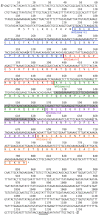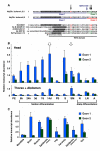The homolog of Ciboulot in the termite (Hodotermopsis sjostedti): a multimeric beta-thymosin involved in soldier-specific morphogenesis
- PMID: 20529303
- PMCID: PMC2896938
- DOI: 10.1186/1471-213X-10-63
The homolog of Ciboulot in the termite (Hodotermopsis sjostedti): a multimeric beta-thymosin involved in soldier-specific morphogenesis
Abstract
Background: Caste differentiation in social insects is a type of polyphenism that enables division of labor among members of a colony. This elaborate social integration has attracted broad interest, although little is known about its regulatory mechanisms, especially in Isoptera (termites). In this study, we analyzed soldier differentiation in the damp-wood termite Hodotermopsis sjostedti, focusing on a possible effector gene for caste development. The gene for an actin-binding protein, HsjCib, which shows a high level of expression in developing mandibles during soldier differentiation, is characterized in detail.
Results: To examine the HsjCib gene, full-length cDNAs were obtained by rapid amplification of cDNA ends-polymerase chain reaction (RACE-PCR) and sequencing. Multiple isoforms were identified, and on the basis of the results of northern and Southern hybridization analyses, these isoforms were considered to be transcriptional variants from a single gene. On the basis of their sequence similarity to homologous genes of other organisms, functions in actin assembly were assumed to be different among isoforms. Expression analysis revealed high expression in the head during soldier differentiation, which was consistent with their allometric growth. Although isoform expression was observed in various tissues, different expression levels were observed among tissues, suggesting the possibility of tissue-specific morphogenetic regulation by HsjCib isoforms.
Conclusion: This study revealed the characteristics and dynamics of the HsjCib gene during soldier differentiation as a potential representative of downstream effector genes in caste-specific morphogenesis. From the expression patterns observed, this gene is considered to be involved in cephalic morphogenesis and neural reorganization, resulting in the establishment of caste-specific morphology and behavior.
Figures





Similar articles
-
Gene expression changes during caste-specific neuronal development in the damp-wood termite Hodotermopsis sjostedti.BMC Genomics. 2010 May 20;11:314. doi: 10.1186/1471-2164-11-314. BMC Genomics. 2010. PMID: 20482890 Free PMC article.
-
Differential gene expression in response to juvenile hormone analog treatment in the damp-wood termite Hodotermopsis sjostedti (Isoptera, Archotermopsidae).J Insect Physiol. 2013 Apr;59(4):509-18. doi: 10.1016/j.jinsphys.2013.02.002. Epub 2013 Feb 26. J Insect Physiol. 2013. PMID: 23481672
-
Caste-specific cytochrome P450 in the damp-wood termite Hodotermopsis sjostedti (Isoptera, Termopsidae).Insect Mol Biol. 2006 Apr;15(2):235-44. doi: 10.1111/j.1365-2583.2006.00632.x. Insect Mol Biol. 2006. PMID: 16640734
-
The making of the defensive caste: Physiology, development, and evolution of the soldier differentiation in termites.Evol Dev. 2020 Nov;22(6):425-437. doi: 10.1111/ede.12335. Epub 2020 Apr 14. Evol Dev. 2020. PMID: 32291940 Review.
-
Body part-specific development in termite caste differentiation: crosstalk between hormonal actions and developmental toolkit genes.Curr Opin Insect Sci. 2024 Jun;63:101183. doi: 10.1016/j.cois.2024.101183. Epub 2024 Feb 29. Curr Opin Insect Sci. 2024. PMID: 38428818 Review.
Cited by
-
Genome-wide and caste-specific DNA methylomes of the ants Camponotus floridanus and Harpegnathos saltator.Curr Biol. 2012 Oct 9;22(19):1755-64. doi: 10.1016/j.cub.2012.07.042. Epub 2012 Aug 9. Curr Biol. 2012. PMID: 22885060 Free PMC article.
-
Social interactions affecting caste development through physiological actions in termites.Front Physiol. 2014 Apr 9;5:127. doi: 10.3389/fphys.2014.00127. eCollection 2014. Front Physiol. 2014. PMID: 24782780 Free PMC article. Review.
-
The TUNEL assay suggests mandibular regression by programmed cell death during presoldier differentiation in the nasute termite Nasutitermes takasagoensis.Naturwissenschaften. 2011 Sep;98(9):801-6. doi: 10.1007/s00114-011-0825-9. Epub 2011 Aug 2. Naturwissenschaften. 2011. PMID: 21808976
-
Cloning, Expression and Effects of P. americana Thymosin on Wound Healing.Int J Mol Sci. 2019 Oct 5;20(19):4932. doi: 10.3390/ijms20194932. Int J Mol Sci. 2019. PMID: 31590392 Free PMC article.
-
The soldiers in societies: defense, regulation, and evolution.Int J Biol Sci. 2014 Mar 5;10(3):296-308. doi: 10.7150/ijbs.6847. eCollection 2014. Int J Biol Sci. 2014. PMID: 24644427 Free PMC article. Review.
References
-
- Wilson EO. The insect societies. Cambridge: Harvard University Press; 1971.
-
- Bignell DE, Eggleton P. In: Termites: Evolution, Sociality, Symbioses, Ecology. Abe T, Bignell DE, Higashi M, editor. Vol. 2000. Dordrecht, The Netherlands: Kluwer Academic Publishers; Termites in ecosystems; pp. 363–387.
-
- Eggleton P. In: Termites: Evolution, Sociality, Symbioses, Ecology. Abe T, Bignell DE, Higashi M, editor. Vol. 2000. Dordrecht, The Netherlands: Kluwer Academic Publishers; Global patterns of termite diversity; pp. 25–51.
-
- Roisin Y. In: Termites: Evolution, Sociality, Symbioses, Ecology. Abe T, Bignell DE, Higashi M, editor. Vol. 2000. Dordrecht, The Netherlands: Kluwer Academic Publishers; Diversity and evolution of caste patterns; pp. 95–119.
Publication types
MeSH terms
Substances
LinkOut - more resources
Full Text Sources

